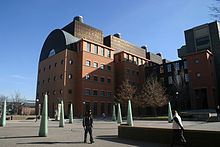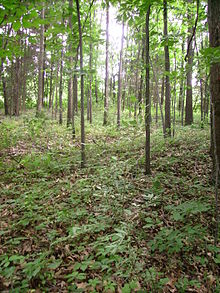Hamilton County, Ohio: Difference between revisions
| Line 211: | Line 211: | ||
*[[Sherwood, Hamilton County, Ohio|Sherwood]] |
*[[Sherwood, Hamilton County, Ohio|Sherwood]] |
||
*[[Turpin Hills, Ohio|Turpin Hills]] |
*[[Turpin Hills, Ohio|Turpin Hills]] |
||
*[[Westwood, Cincinnati|Westwood]] |
|||
*[[White Oak East, Ohio|White Oak East]] |
*[[White Oak East, Ohio|White Oak East]] |
||
*[[White Oak West, Ohio|White Oak West]] |
*[[White Oak West, Ohio|White Oak West]] |
||
Revision as of 01:59, 7 July 2007
Hamilton County | |
|---|---|
 Location within the U.S. state of Ohio | |
 Ohio's location within the U.S. | |
| Coordinates: 39°12′N 84°32′W / 39.2°N 84.54°W | |
| Country | |
| State | |
| Founded | January 2 1790[1] |
| Named for | Alexander Hamilton |
| Seat | Cincinnati |
| Largest city | Cincinnati |
| Population (2000) | |
| • Total | 845,303 |
| Time zone | UTC−5 (Eastern) |
| • Summer (DST) | UTC−4 (EDT) |
| Website | www |
Hamilton County is a county in the located in the southwest corner of the state of Ohio, United States. The county seat is Cincinnati, and as of 2000, the population was 845,303. This made it the third most populous county in Ohio (and Ohio's second most densely populated county).[citation needed] The county is named for the first Secretary of the Treasury, Alexander Hamilton.[2]
History
Most of Hamilton County was originally owned and surveyed by John Cleves Symmes, and the region was a part of the Symmes Purchase. The first settlers came down the Ohio River in 1788, and established the towns of Losantiville (later Cincinnati) and Cleves.
In 1790, Hamilton County was organized as the second county in the Northwest Territory. At that time its area included about an eighth of Ohio, and had 2,000 inhabitants (not counting Native Americans). Since then, other counties have been organized and its area reduced to its current size. Rapid growth occurred during the 1830s and 1840s as the area became a magnet for German and Irish immigrants.
During the Civil War, Morgan's Raid (a Confederate cavalry assault) passed through the northern part of the county in 1863.
Government
Main article: Ohio county government.

As of 2005, the Hamilton Board of County Commissioners are R. Patrick DeWine, Phil Heimlich, and Todd Portune. Heimlich was elected in 2002, replacing Tom Neyer, Jr., who was president from 1999 through 2002. Since 1963, the Board has employed an administrator to run the day-to-day operations of the county. In November 2006, Heimlich was defeated by challenger David Pepper who replaced Heimlich in January, 2007.
Other elected officers include Dusty Rhodes (auditor), Joe Deters (prosecutor) and Simon L. Leis, Jr. (sheriff).
Geography
According to the U.S. Census Bureau, the county has a total area of 1,069 km² (413 mi²). 1,055 km² (407 mi²) of it is land and 14 km² (5 mi²) of it (1.31%) is water.
Geographic features
The county lies in a region of gentle hills formed by the slopes of the Ohio River valley and its tributaries. Besides the Ohio, the Great Miami River, the Little Miami River and the Mill Creek contribute to this system of hillsides and valleys. Some steep hillsides reflect rapid changes in elevation but are usually confined to the nature of one sided hills.
The county boundaries include the lowest point in Ohio, where the Ohio River passes the Indiana border.
Major highways
Interstate 71, Interstate 74, Interstate 75, Interstate 471 and Interstate 275 serve the county. The Norwood Lateral and Ronald Reagan Highway are also prominent east-west thoroughfares in the county.
Railroads
CSX Transportation, Norfolk Southern, RailAmerica, and Amtrak. Railroads of Cincinnati

Adjacent counties
- Butler County, Ohio - north
- Warren County, Ohio - northeast
- Clermont County, Ohio - east
- Boone County, Kentucky - southwest
- Kenton County, Kentucky - south
- Campbell County, Kentucky - southeast
- Dearborn County, Indiana - west
Demographics
| Hamilton County Population by year[1] | |
|
2000 845,303 | |
As of 2000, there were 845,303 people, 346,790 households, and 212,582 families residing in the county. The population density was 801/km² (2,075/mi²). There were 373,393 housing units at an average density of 354/km² (917/mi²). The racial makeup of the county was 72.93% White, 23.43% Black or African American, 0.18% Native American, 1.61% Asian, 0.03% Pacific Islander, 0.51% from other races, and 1.32% from two or more races. 1.13% of the population were Hispanic or Latino of any race.
There were 346,790 households out of which 30.20% had children under the age of 18 living with them, 43.40% were married couples living together, 14.30% had a female householder with no husband present, and 38.70% were non-families. 32.90% of all households were made up of individuals and 10.60% had someone living alone who was 65 years of age or older. The average household size was 2.38 and the average family size was 3.07.
In the county the population was spread out with 25.80% under the age of 18, 9.60% from 18 to 24, 29.70% from 25 to 44, 21.50% from 45 to 64, and 13.50% who were 65 years of age or older. The median age was 36 years. For every 100 females there were 91.10 males. For every 100 females age 18 and over, there were 86.80 males.
The median income for a household in the county was $40,964, and the median income for a family was $53,449. Males had a median income of $39,842 versus $28,550 for females. The per capita income for the county was $24,053. About 8.80% of families and 11.80% of the population were below the poverty line, including 16.20% of those under age 18 and 8.70% of those age 65 or over.
Localities

Cities
Villages
Townships
|
Census-designated places
- † Only partially in Hamilton County
Other localities
Education
Public elementary and secondary education is provided by a number of independent school districts, supplemented by a county vocational school district, the Great Oaks Institute of Technology and Career Development. The parochial schools of various denominations add to this base. Among these the Roman Catholic Archdiocese of Cincinnati maintains a system of 108 elementary and 22 secondary schools, the ninth largest private system in the United States.
Colleges and universities

Recreation

The county, in cooperation with the City of Cincinnati, operates the Public Library of Cincinnati and Hamilton County system with a main library and 41 branches. Major sports teams are listed under the communities in which they are located, primarily Cincinnati. The County Park District maintains a series of preserves and educational facilities. The three major parks within the system are Miami Whitewater Forest, Winton Woods, and Sharon Woods.
References
- ^ a b "Ohio County Profiles: Hamilton County" (PDF). Ohio Department of Development. Retrieved 2007-04-28.
- ^ "Hamilton County data". Ohio State University Extension Data Center. Retrieved 2007-04-28.

